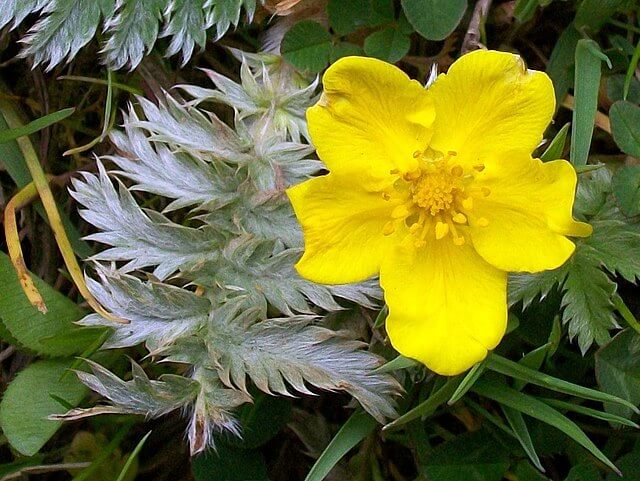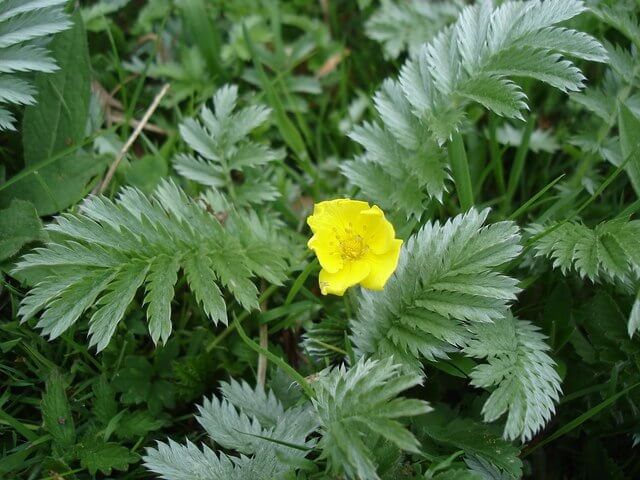Silverweed, also known as Goosefoot or Silvery Cinquefoil, is an edible plant surrounded by contradiction. It is claimed to be native to both North America and Asia, and no one is quite sure which is true—but it has popped up on several continents around the world. On top of that, this delectable weed has two scientific names. Known as both Potentilla anserina and Argentina anserina, botanists are arguing over the true classification of Silverweed to this day. Everyone can agree, however, that it is a member of the Rosaceae family, and it has been a staple wild food source around the world for centuries.

While it is possible to find Silverweed inland along creeks, rivers, and even in some sandy soils, it grows best right off of coastal beaches. Foragers can find this squat, wide plant growing along the northern portions of both US coasts, but they will have more luck along the Western seaboard. Silverweed grows prolifically in moist conditions and thrives in coastal forests. Silverweed gets its name from the silvery white hairs growing on its pointed, saw-toothed leaves. The plant’s foliage grows along fern-like fronds, with the hairs concentrated most on the underside of the leaves. Another distinctive trait is Silverweed’s bright yellow blooms that cover the plants all summer long. The five-petaled flowers grow on single stalks protruding as tall as one foot in the air. Some people liken these flowers to buttercups due to their rich yellow hue.
Edibility and Culinary Use
While the entire Silverweed plant is technically edible, many people report that the leaves are bitter and lackluster. This plant’s prized flavor lies in its roots, often compared to the flavor of parsnips or sweet potatoes. Like other starchy tubers, Silverweed roots are excellent roasted, boiled, raw, fried, or mashed. Essentially, if you can make a recipe with a potato, you can make it with Silverweed root! The roots can be dried and powdered to make a starchy thickener, and its raw flowers are a beautiful addition to mixed salads. The plant reproduces through underground runners, forming new sprouts from nodes, so taking a few pieces of tuber will leave the plant able to regenerate.
Medicinal Uses of Silverweed
Since Silverweed grows all over the world, many cultures have found medicinal uses for it through the centuries. It is rumored that ancient people brewed the leaves into a strong tea to treat lockjaw. The entire plant contains tannins, though they are most concentrated in the roots, and Native Americans use a similar tea as an astringent, anti-inflammatory rinse to treat sore throats and tooth pain. Silverweed tea has traditionally been used to treat menstrual cramps, and the entire plant can be placed against the skin to act as a pain-reliever. This plant is a medicinal powerhouse that makes a valuable contribution to the forager’s herbal kit.

Cautions
Some people report stomach pain after eating Silverweed, so it is recommended to try a small quantity and wait twenty-four hours before further consumption to see how it will affect you. Unfortunately, this plant has a rather convincing lookalike to the untrained eye—Creeping Cinquefoil (Potentilla reptans). While its flowers and leaf shape are virtually identical, Creeping Cinquefoil’s foliage sports no white hairs like Silverweed, and its leaves grow in clumps rather than along a frond. Still, it is up to you as the forager to be certain that you properly identify the species before consumption.
Conclusion
Silverweed is a fascinating edible plant backed by ancient history and scientific controversy. Its roots are equally as medicinal as they are delicious, and it is an excellent source of starch for coastal foragers. As a running perennial, Silverweed can be foraged with a clear conscience because it reproduces quickly underground, making it an exceptional replenishing food choice.
Many of our readers find that subscribing to Eat The Planet is the best way to make sure they don't miss any of our valuable information about wild edibles.
See our privacy policy for more information about ads on this site






